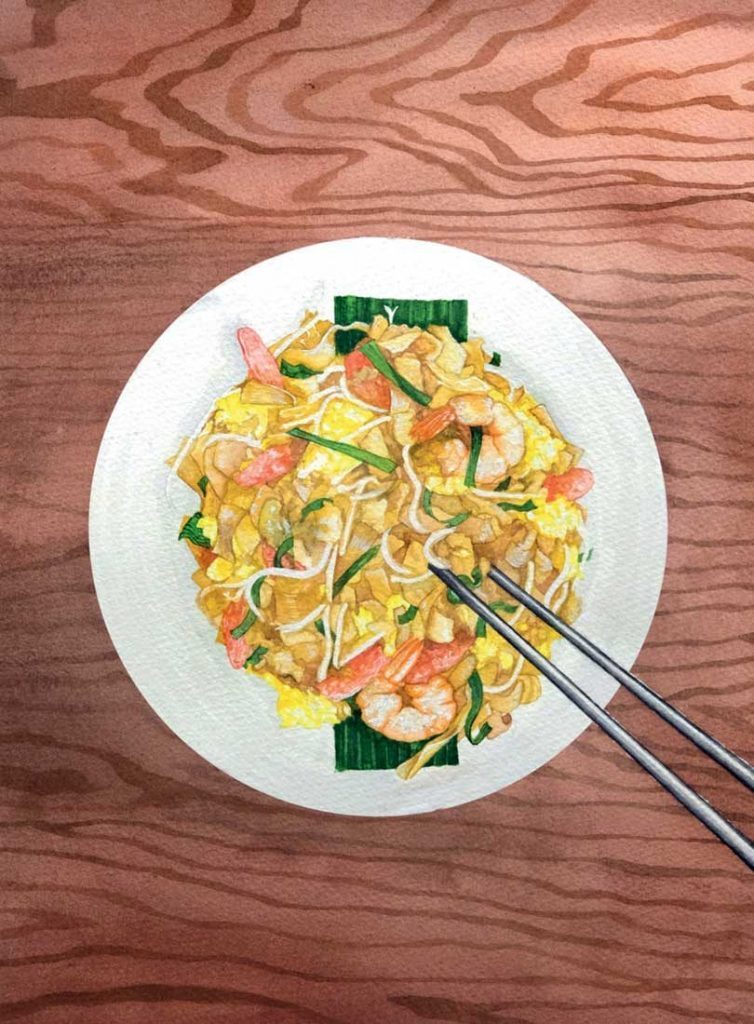CHAR KOAY TEOW
Little Penang

Serves
4Preparation
20 minsCook
15 minsIngredients
| FOR THE CHILLI PASTE | |
| 100g dried seeded chilli or chilli flakes | |
| 1 tablespoon oil | |
| FOR THE SAUCE | |
| 6 tablespoons light soy sauce | |
| 1 ½ tablespoons dark soy sauce | |
| 1 tablespoon sugar | |
| ½ teaspoon fish sauce | |
| pinch of salt | |
| pinch of white pepper | |
| 300g pork back fat, diced into small cubes | |
| 1kg fresh flat rice noodles | |
| 1 whole bulb garlic, finely chopped | |
| 12 prawn cutlets (chosen from a sustainable source) | |
| 2 sticks Chinese sausage, sliced diagonally and thinly into bite sizes, about 3cm in length | |
| 4 large eggs | |
| 250g fresh bean sprouts, rinsed in cold water | |
| 1 bunch Chinese chives, roots cut off then cut into pieces approx 5 cm in length |
The essential ingredients for CKT are pretty simple but the success lies in the mixture of the sauce, the chilli paste, the freshness of the flat rice noodles and other key ingredients and, most importantly, the control of heat of the wok during frying. The secret in good char koay teow lies in the timing, and the way the heat of the wok and style of frying is controlled. A very hot wok will produce a plate of fragrant and smoky noodles, but have the heat too high and not properly controlled and you’ll have burnt ingredients and broken, clumpy noodles. We use lard as it is smooth, resistant to higher heat and definitely more aromatic when frying! The amount of chilli and sauce can be added according to liking although too much sauce will result in soggy noodles. If you prefer a saltier taste, then add in more salt in the sauce but keep the liquid ingredients constant.
We import our own sauces as we know the origin and hence the integrity of the sauce. We find that the sauces made in Malaysia are definitely superior in taste with no mechanical aftertaste.
This quantity makes four serves but it’s best to fry one portion at a time to preserve the heat of the wok. So, once you have made the chilli paste and the sauce, divide all the ingredients into four portions before cooking.
TEE CHIEW PHIE
Instructions
| 1. | To make the chilli paste, soak the chillies in warm water for 5 minutes, then drain and blend to a fine paste. |
| 2. | Heat a wok, add the oil and fry the paste on a low heat until fragrant or until the oil separates from the chilli. |
| 3. | Add a pinch of salt then put into a bowl and set aside. |
| 4. | Mix all the ingredients for the sauce thoroughly until dissolved, and set aside. |
| 5. | Wash the wok well and heat up again. |
| 6. | Fry the diced pork fat on a moderate heat until the pork fat is released and crisped up, then put into a bowl and set aside. |
| 7. | Ensure the fresh rice noodles are loose and not clumped together. |
| 8. | Divide all the ingredients into four portions. |
| 9. | Working one portion at a time, heat the wok and add back the pork lard with crisp fat. |
| 10. | Quickly add the garlic and chilli paste according to taste. |
| 11. | Add in the prawns and stir fast and thoroughly. |
| 12. | Add in the pork sausage and continue stirring. |
| 13. | Once the prawns change colour and start to cook, add in the noodles. |
| 14. | Once the noodles are in, turn up the heat but continue to stir well. |
| 15. | Add in the sauce to cover the noodles, and continue stirring until the noodles turn soft and fragrant. |
| 16. | Move the noodles to the side of the wok and add in a bit of oil then crack an egg into the empty wok space. |
| 17. | Once the egg starts to cook slightly, cover it with the noodles and continue stirring. |
| 18. | Add in the bean sprouts and continue stirring again. |
| 19. | Add in the Chinese chives last and with a quick couple of stirs, dish out the noodles and serve immediately. |
Recipe by Little Penang / Illustration Kohl Tyler-Dunshea

Leave a Reply